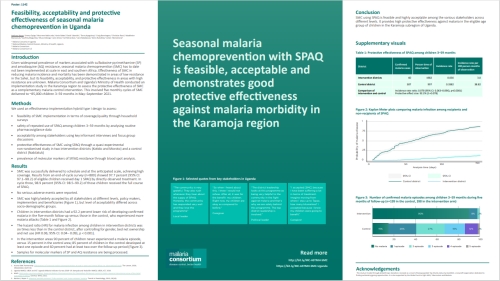
Publication Date:
20/11/2021
Author:
Anthony Nuwa
Jimmy Opigo
Maureen Nakirunda
Kevin Baker
David Salandini
Tonny Kyagulanyi
Craig Bonnington
Christian Rassi
Madeleine Marasciulo
Godfrey Magumba
Musa Odongo
Jane Achan
Sol Richardson
Jane Nabakooza
Denis Rubahika
James Tibenderana
Type:
Poster

Feasibility, acceptability and protective effectiveness of seasonal malaria chemoprevention in Uganda
Publication Date:20/11/2021
Author:
Anthony Nuwa
Jimmy Opigo
Maureen Nakirunda
Kevin Baker
David Salandini
Tonny Kyagulanyi
Craig Bonnington
Christian Rassi
Madeleine Marasciulo
Godfrey Magumba
Musa Odongo
Jane Achan
Sol Richardson
Jane Nabakooza
Denis Rubahika
James Tibenderana
Type:
Poster
SMC with SPAQ is feasible, acceptable and demonstrates good protective effectiveness against malaria morbidity in the Karamoja region.
Given widespread prevalence of markers associated with sulfadoxine-pyrimethamine (SP) and amodiaquine (AQ) resistance, seasonal malaria chemoprevention (SMC) has to date not been implemented at scale in east and southern Africa. Effectiveness of SMC in reducing malaria incidence and mortality has been demonstrated in areas of low resistance
in the Sahel, but its feasibility, acceptability, and protective effectiveness in areas with high resistance are unknown. Malaria Consortium and Uganda’s Ministry of Health conducted an implementation study in the Karamoja region to assess the protective effectiveness of SMC as a complementary malaria control intervention. This involved five monthly cycles of SMC
delivered to ~85,000 children 3–59 months in May–September 2021.
This poster was presented at the 70th annual meeting of the American Society of Tropical Medicine and Hygiene.
Country: Uganda
Keywords: Community delivery | Malaria | SMC | SDGs
« Back to Publications